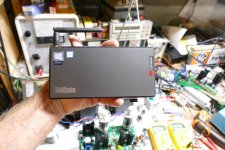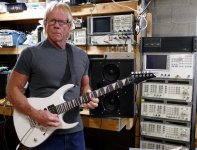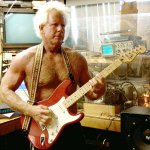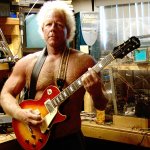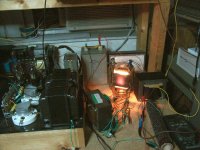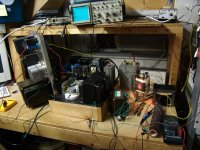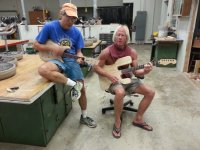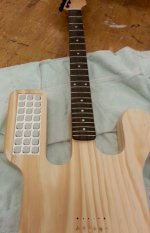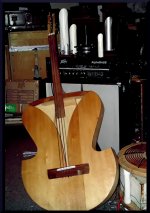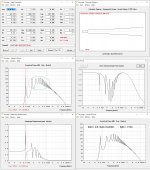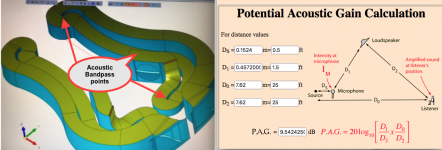This pdf shows the folded horn area, it is the space between the wood components that
form the actual horn. Note the compression chamber (tuned to 89 Hz). Also note the exponential growth of the horns. The acoustic impedance matching is the real benefit. Other advantages include directivity, symmetrical horns in stereo that allow sound wave convergence, and great bass response due to capturing 1/4 wavelength of lowest frequency, with five foot horn length. Only small speakers will fit inside a guitar, so this bass response is critical. Again, this is in addition to all soundboard low, middle and high response.
form the actual horn. Note the compression chamber (tuned to 89 Hz). Also note the exponential growth of the horns. The acoustic impedance matching is the real benefit. Other advantages include directivity, symmetrical horns in stereo that allow sound wave convergence, and great bass response due to capturing 1/4 wavelength of lowest frequency, with five foot horn length. Only small speakers will fit inside a guitar, so this bass response is critical. Again, this is in addition to all soundboard low, middle and high response.
Joe K, wonder what would result if you put the guitar bridge upon a small diameter tympanic membrane (i.e. banjo) and used the backside of that as the horn "driver" or source?
A regular acoustic sort of works that way, if you consider a radius around the bridge as flexing, driven by the strings. It radiates sound off the front surface as well as into the body chamber, with the sound hole being the cabinet port.
I imagine it would be quite a challenge to find suitable materials for the membrane; it'd have to take the downward force of the strings at least, if you used a trapeze tail piece to take the string tension.
Wanna go further and weirder? A magnetic device pushes back, balancing the string force, so the membrane doesnt have to be so taught to take it. More flexible allows lower frequencies. They have pretty strong magnets these days, but, unsure what that would do to the bridge assembly, which you'd want to be pretty low in mass.
A regular acoustic sort of works that way, if you consider a radius around the bridge as flexing, driven by the strings. It radiates sound off the front surface as well as into the body chamber, with the sound hole being the cabinet port.
I imagine it would be quite a challenge to find suitable materials for the membrane; it'd have to take the downward force of the strings at least, if you used a trapeze tail piece to take the string tension.
Wanna go further and weirder? A magnetic device pushes back, balancing the string force, so the membrane doesnt have to be so taught to take it. More flexible allows lower frequencies. They have pretty strong magnets these days, but, unsure what that would do to the bridge assembly, which you'd want to be pretty low in mass.
Last edited:
jj - you are crazy, good crazy! I like that idea, the banjo drowns me out every time. Of course that is because the "soundboard" is pretty much a drum skin. One of my goals is to see if others can improve on this idea, right up your alley, try it! The magnets, did not think of that at all, like it!
I am also a blues harp player. I know the reed provides much of the sound, but a blues harp also includes a very small horn, and then also the "horn" made by your hands if you do it correctly. I can blow an acoustic guitar out of the water with a blues harp, have done it many times. Why do I like horns, because they work!
Would love to hear from blues harp players and also horn players, brass sections are so powerful.
I am also a blues harp player. I know the reed provides much of the sound, but a blues harp also includes a very small horn, and then also the "horn" made by your hands if you do it correctly. I can blow an acoustic guitar out of the water with a blues harp, have done it many times. Why do I like horns, because they work!
Would love to hear from blues harp players and also horn players, brass sections are so powerful.
I never intended to become a Rock Star.. Deep Purple played the first Concert in Bern Switzerland end 1967 Just turned 15, this was with Rod Evans Singer, and Nick Simper Bass, there was Ritchie Blackmore, Jon Lord, and Ian Pace, playing cover songs as you can hear on the Deep Purple Album shades of Deep Purple..I saw Jimi in Miami Beach in 1967 when he was the opening act for the Monkees. I was also 15. That show was the end of my dream of being a rock star. There was no way my 60's surf music guitar playing could ever compete.
That was the time for me to face the truth, that I never would reach that level of guitar playing, and better would keep it for me.. even we had a band at that time. but it did not last long.. to little effort into that Practicing... so the rest of my music career stayed in my home.. May better so..
But I never stayed away from concerts, saw so many groups.. because Switzerland was the Mekka for Concerts at that time.. All big names were here, except the Beatles.. Never ever played in Swiss..
Paul McCartney did in 2004, the first time ever. And I still going to attend concerts, today at nearly 70..
Sorry @ Joe K not trying to hijack your thread..
Call it nostalgic..
Last edited:
I never intended to become a Rock Star..
I really didn't either, but did dream about it. I knew from the moment the paper clip met the wall socket (age 4) that my life's work would be in electronics. I also knew that from making my first "guitar amp" out of an old Magnavox HiFi at age 7 my interests in music and electronics would be forever intertwined. An Emerson Lake and Palmer concert in 70 or 71 convinced me to start making music synthesizers, even though I knew I would never be an Emerson or Wakeman.
I also played in a garage band in the 60's and we did a decent job of the popular surf music of the day. The Hendrix show let me see that there was a whole new level of guitar playing and showmanship out there that we were not even aware of. The Monkees on the other hand were proof that below average musicians could become popular with the right production and money behind them. Ditto Grand Funk Railroad in the 70's.
The mountain that I haven't yet climbed? Is it possible to put Ableton Live or FL studio INSIDE the guitar. Yes, I have seen the guitars with a MIDI controller attached to them, both electric and acoustic. Is it possible to put everything including the PC inside the guitar?
This PC will run for hours on a Lithium battery pack from a model helicopter.
Attachments
Nice Job.. But I do like the original sound.. I like computers., have a lot here at home..
So, I miss this Yamaha 325 I bought in the past..
Your workbench looks better than mine..
And to your Signature I have to say this.. Read below why
I let the smoke out of the Transistors as long the device is under Test on that Workbench, but as soon it has been fixed into the BOX, no more smoke allowed...
Recently I watched a Video of Nelson Pass, attending BAF 2019, @ Minute 16 or so he made a speech... These Emitter Resistor have reason to be there,, to keep the smoke inside the Transistors.. He's a guy with great humor...
BTW the Avatar is this you with this LES Paul.. Sunburst isn't it_
So, I miss this Yamaha 325 I bought in the past..
Your workbench looks better than mine..
And to your Signature I have to say this.. Read below why
I let the smoke out of the Transistors as long the device is under Test on that Workbench, but as soon it has been fixed into the BOX, no more smoke allowed...
Recently I watched a Video of Nelson Pass, attending BAF 2019, @ Minute 16 or so he made a speech... These Emitter Resistor have reason to be there,, to keep the smoke inside the Transistors.. He's a guy with great humor...
BTW the Avatar is this you with this LES Paul.. Sunburst isn't it_
Last edited:
I let the smoke out of the Transistors as long the device is under Test on that Workbench, but as soon it has been fixed into the BOX, no more smoke allowed...
BTW the Avatar is this you with this LES Paul.. Sunburst isn't it_
I worked at Motorola for 41 years. I started on the assembly line making HT-220 walkie talkies, and left as a Principle Staff Research Engineer, having acquired two college degrees and a few patents at their expense.
I am known on this forum for blowing up vacuum tubes, but truth be known I have fried far more silicon, GaN, GaAs, and SiC than vacuum tubes. Probably as much or more than Nelson, and I was paid to do most of it (high efficiency RF power amp design from 136 MHz to 2.6 GHz) or got free sample silicon for dozens of DIY solid state audio amps and computers in the 70's through the 90's, by having a ham radio friend in the Semiconductor Sales office.
That is me behind the Red Sunburst Epiphone Les Paul, which was a 50th birthday gift from my wife. The avatar picture is from 2005. I included a better picture that makes the time frame a bit more obvious, note the CRT computer monitor and TV set. I was abusing a 200 watt single ended guitar test amp made with a large 833A transmitting tube with both the Les Paul and a Squier Strat. The amp was a crazy dangerous test with a 1500 volt power supply out of a transmitter. Note the 6mm thick sheet of polycarbonate between me and the amp in most of the pictures. It only existed for 1 week at which point it was dismantled.
Here is a picture of the other end of the workbench with a stack of RF test equipment. This guitar is one I got on Ebay for under $40. It is playing through a DIY 4 tube 4 watt push pull tube amp that I designed with cost as the primary design criteria. There is about $50 worth of material in the amp head, less the wood case which was not done when this picture was taken (3 years ago). I like that amp and still use it a lot.
I had a poorly made white Fender Squier Strat that I took in trade for a bunch of vacuum tubes a dozen years or so ago. I never really liked it so I sold it for enough money to purchase 3 cheap Chinese guitars on Ebay. This one, a Strat clone, and a Fender Precision bass clone. The Strat clone is the worst of the three, and it still plays better than the Squier that I sold.
My favorite guitar was an old Hagstrom I with the plastic front. Unfortunately it was stolen back in 1975. My playing skills have faded to where I use mostly budget guitars today, but I still have the Les Paul and a few other goodies from my past. I still have the red Squier Strat seen in the other 200 watt guitar test picture, although it is currently in pieces. I had borrowed its neck for an experimental DIY guitar with a MIDI controller inside.
Attachments
OK, I'll admit I always wanted to be good at playing blues harp. I used to carry one around in my pocket as a teenager. Then me and a friend went to see Dave Brubeck and sons play at Saratoga Performing Arts. They had Peter "Madcat" Ruth with them. Seeing that guy hold the whole audience pin-drop captive during his solo on that giant stage - well it was like when George (Tubelab) went to see Hendrix. Knowing I'd never develop a talent even close to what I saw (effortless legato with bends across the whole range of the harp), I just gave up on the instrument.
Nevertheless, I'm still intrigued by the physics on how you bend a note. I've thought its by putting a really high Q resonant chamber over the reed note, dragging it flat - all with your mouth of course. I could only ever do it on a couple-few notes, only the suck notes, never the blow. On a chromatic harp forget it - couldnt do anything like that - too big for my breath.
Nevertheless, I'm still intrigued by the physics on how you bend a note. I've thought its by putting a really high Q resonant chamber over the reed note, dragging it flat - all with your mouth of course. I could only ever do it on a couple-few notes, only the suck notes, never the blow. On a chromatic harp forget it - couldnt do anything like that - too big for my breath.
Stroh instruments, with their bridge coupled to a diaphragm - horn assembly quite similar to those used in its time with acoustic phonographs. were commonly used in making acoustic recordings. (back in the "70's" a violin model was featured in a Gong Show act and sounded impressive - but was "gonged"...)
The Stroh Violin Played a Role in Early Music Recording and Are Still in Use Today | Strings Magazine
Stroh violin - Wikipedia.

I'd imagine a guitar body n such as the "Nashville Nylon" could be worked out to give more of the cavity/aperture sound and work well with a small amplifier.
Chet Atkins probably would have latched onto something in this vein.
here's a bass guitar in my mess - - it could have used a brace on the upper bout - hahaha - purely acoustic instruments like this would work alright.
The Stroh Violin Played a Role in Early Music Recording and Are Still in Use Today | Strings Magazine
Stroh violin - Wikipedia.

I'd imagine a guitar body n such as the "Nashville Nylon" could be worked out to give more of the cavity/aperture sound and work well with a small amplifier.
Chet Atkins probably would have latched onto something in this vein.
here's a bass guitar in my mess - - it could have used a brace on the upper bout - hahaha - purely acoustic instruments like this would work alright.
Attachments
Last edited:
More thoughts on a classic guitar in an orchestra. Yes it is a featured instrument, but no it is not a standard instrument. The links above show violins and other instruments playing with so much power and beauty, and the classical guitar, even with a small amplifier can not keep up (I am talking volume here). The guitar, by its nature does not belong to the collective, it is more of an individual instrument, or of course played with a band.
The guitar being played alone or with voice is a natural. A violin, cello, trumpet...are not generally individual instruments, they do well with a collective, an orchestra. Exponential wood horns (not plastic) inside a guitar are a natural extension of the instrument. I will have some chips flying off a CNC machine tomorrow for a partial prototype of the horn itself. Results will be interesting.
The guitar being played alone or with voice is a natural. A violin, cello, trumpet...are not generally individual instruments, they do well with a collective, an orchestra. Exponential wood horns (not plastic) inside a guitar are a natural extension of the instrument. I will have some chips flying off a CNC machine tomorrow for a partial prototype of the horn itself. Results will be interesting.
If its a success tonally then I'd expect a good audience for such an instrument..
The horn's mouth is quite small compared to path length so in a rough sim looks reasonably smooth to an octave about the low E. Maybe that won't matter (?) if the lower notes outputs are mainly harmonics in the first place.
In this rough sim, I assumed a Faitalpro 3fe22 and rather large mouth
The horn's mouth is quite small compared to path length so in a rough sim looks reasonably smooth to an octave about the low E. Maybe that won't matter (?) if the lower notes outputs are mainly harmonics in the first place.
In this rough sim, I assumed a Faitalpro 3fe22 and rather large mouth
Attachments
If its a success tonally then I'd expect a good audience for such an instrument..
The horn's mouth is quite small compared to path length so in a rough sim looks reasonably smooth to an octave about the low E. Maybe that won't matter (?) if the lower notes outputs are mainly harmonics in the first place.
In this rough sim, I assumed a Faitalpro 3fe22 and rather large mouth
A small guitar I made years ago.

Thanks. If I were building a speaker or combo amp for miced regular classical guitar, I might choose (vs horn or direct radiator) a 10 inch Karlson type, with coax or like Karlson's "X15" model with slotted pipe tweeter.
Placing the K-tube on top might be best when working with an ensemble
That's a 15" speaker -
https://i.imgur.com/TNsaLCP.jpg
Placing the K-tube on top might be best when working with an ensemble
That's a 15" speaker -
https://i.imgur.com/TNsaLCP.jpg
Joe,What I am trying to do is make the acoustic guitar louder and also keep that beautiful natural acoustic sound...
1)Plus the horns may add some good sound qualities, as the entire body will be loaded with sound waves and vibration, but that of course is unknown right now.
2)I also believe it can cut down on unwanted guitar distortion, string buzz...due to being able to play softer and get a "bigger" sound.
1) If the entire body will be loaded with sound waves and vibration, it will reduce the potential acoustic gain (PAG) before feedback to essentially none.
Best case with the mic .125' (1.5") and the horn exits about 1.5' away could be as much as 21 dB, though due to leakage, and the horn exit output sympathetically vibrating the body/mic chamber I'd guess about 10dB gain max in the real world.
10dB gain would sound about twice as loud.
2) The softer one plays, the less PAG.
The reduced chamber volume will reduce the SPL (sound pressure level) at the mic, reducing PAG.
Regarding the folded horns output- the front chamber appears to be fairly large before the throat constriction, which will create an acoustic low-pass filter, severely attenuating any high-frequencies and harmonics, the output will be quite "dull" in comparison to an acoustic sound.
In addition, the corner bends are not parabolic as in horn instruments or "re-entrant" PA horns, which will cause more high frequency attenuation and severe peaks and troughs in the output.
At any rate, your instrument will sound "interesting"
Best of luck,
Art
Attachments
- Home
- Live Sound
- Instruments and Amps
- Folded Horn Acoustic Guitar Patent # 10,777,172
